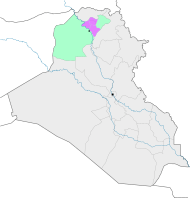Mar Mattai Monastery
Dayro d-Mor Mattai (Syriac: ܕܝܪܐ ܕܡܪܝ ܡܬܝ;The Monastery of St. Matthew, Arabic,دير مار متى)[1] is located atop Mount Alfaf in northern Iraq and is 20 kilometers from Mosul. It is recognized as one of the oldest Christian monasteries in existence and is famous for its magnificent library and considerable collection of Syriac Christian manuscripts.[2] It is also the center of an Archbishopric, with Bishop Mor Timothius Mousa A. Shamani serving.
 | |
 Location within Iraq | |
| Monastery information | |
|---|---|
| Other names | Dayro d-Mor Mattai |
| Order | Syriac Orthodox Church |
| Established | 363 |
| Dedicated to | Mor Mattai |
| Site | |
| Location | near Bartella, Nineveh, |
| Coordinates | 36.49°N 43.442778°E |
History

The monastery was founded in 363 by the hermit Mar Mattai who had fled persecution in Amid under the Roman Emperor Julian the Apostate. According to Syriac tradition, he was involved in healing the sister of Mor Behnam and converting the brother and sister to Christianity. Their father, King Sinharib of Assyria initially killed his son and daughter but later recanted and awarded Mattai a place atop Mount Alfaf to establish his monastery. Mattai was quickly joined by a small group of Syriac followers, and under his leadership that community developed a true monastic ethos.
In the 12th century, after storming a nunnery in Khudida, Kurds attacked the monastery for four months with 1,000 horsemen and foot soldiers. The monks burnt the ladders to prevent entry. Then, two large boulders were rolled against the walls from above and caused a hole which the kurds tried to force their way in. The monks successfully fought back with stones and darts. Then, they repaired the walls. Abbot Abunser lost an eye in this battle. Eventually, the kurds were bribed with the gold and silver from the churches, and afraid of a mongol attack, they retreated.[3]
In 1171, neighbouring Kurds led several attacks on the monastery and were repelled by a coalition of monks and local Christians. The Kurds promised the monks they would cease their attacks and paid them 30 dinars and the monks sent the local Christians back to their villages in the belief that the monastery would be safe. Later, a force of 1500 Kurds succeeded in pillaging the monastery and killing 15 monks who did not find refuge in the upper citadel. The monks who survived the attack abandoned the monastery and relocated to Mosul. Upon hearing of the attack, the governor of Mosul attacked the Kurds, killing many; in retaliation the Kurds destroyed nine Assyrian villages, killing their inhabitants and attacked the Monastery of Mar Sergius.[4]
In 1369, another Kurdish attack on the monastery damaged many manuscripts. During the 19th century, Kurds looted the monastery numerous times.[5]
The monastery is currently maintained by the Syriac Orthodox Church, and serves the small farming village below. Every year, Christians of various church denominations gather in the monastery on September 18 to commemorate the day of Mar Matti's death.[6]
References
| Wikivoyage has a travel guide for Mar Mattai. |
- Thomas A. Carlson et al., “Mor Matay — ܕܝܪܐ ܕܡܪܝ ܡܬܝ ” in The Syriac Gazetteer last modified June 30, 2014, http://syriaca.org/place/227.
- Michael Goldfarb, Ahmad's War, Ahmad's Peace (New York: Carroll & Graf, 2005).
- Howorth, Henry (1888). History of the Mongols: From the 9th to the 19th Century , Part III. New York: Burt Franklin. p. 180.
- Moosa, Matti (28 April 2012). "The Christians Under Turkish Rule".
- "Monastère de Mor Mattai - Mossul - Irak" (in French). Archived from the original on 3 March 2014.
- "القديس مار متى الناسك والشهداء مار بهنام وسارة ورفاقهما الأربعين". Archived from the original on 2018-12-26. Retrieved 2014-06-11.
